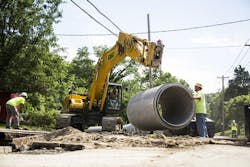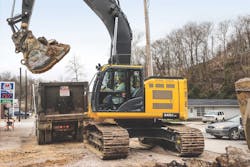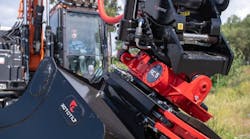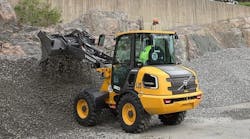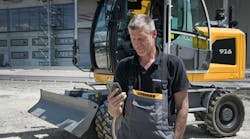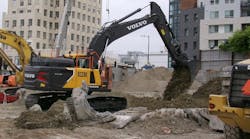Chuck Yengst, president of Yengst Associates, Wilton, Connecticut, says sales for the category have improved 15 percent, year-over-year. “For 2017, it was about 5,700 units sold, and for 2018 the estimated level of sales will be roughly 6,500 units,” Yengst says. “This segment of the hydraulic excavator market accounts for about 20 percent of total industry sales.”
Yengst says Caterpillar, John Deere, and Komatsu are the top three suppliers, in order.
“The market has been growing over the past five years, with the 80,000-pound size class growing the fastest, up about 40 percent since 2013,” says Jonny Spendlove, product marketing manager, excavators, for John Deere and Hitachi. “The overall growth of the economy has contributed to this, and we see particularly strong industry growth in residential and commercial building, underground, and site-development applications.”
Corey Rogers, marketing manager for Hyundai, digs even deeper into the numbers. “Several of the largest statewide excavator markets saw significantly more growth—as much as 75 percent,” Rogers says. “Texas alone accounts for about 25 percent of the domestic market for 28- to 40-ton excavators. The oil and gas industry drives a big part of the overall growth.
“Looking at other SIC industry codes, we find concentrated sales of excavators in this weight class among contractors engaged in general excavation/site prep, water and sewer pipelines, highway and street construction, and underground utilities,” Rogers says.
Steps to buying a crawler excavator
With all the possible applications and manufacturers’ model choices available to managers, having a game plan before buying is essential.
“Any manager should consider productivity—how much dirt an operator can move in an hour or a day,” Spendlove says. “The labor market is tight, as operators are in short supply and wages are going up, so it’s important to get as much productivity as possible out of each hour of labor.”
The size of the unit should be matched to the types of jobs it is required to do. “Consider the size of the job site,” Spendlove advises. “Reduced-tail-swing excavators can be exceptional options for tight job sites, such as roadside work, where a standard tail swing excavator might require an extra lane of traffic to close down.”
“The working range and lift capability are also very important because large jobs will often have strict deadlines, with fines applied if a contractor does not complete the work on-time,” says Komatsu product manager Andrew Earing. “Ensuring the machine is sized for proper dig depths and payload will avoid unexpected delays and unplanned machine rentals.”
Hyundai’s Rogers advises managers to consider dealer support, and machine size, among other factors.
How dealers support excavator acquisition
“First of all, it’s important to have a good, trusting relationship with your dealer and their professional sales staff,” Rogers says. “A reliable dealer will help make sure you’re getting the right machine at the right price for the jobs you need to do. Also, consider the opinions of your experienced operators who are out there using this equipment every day.
“Know what you need the machine to do for you,” Rogers says. “Understand what the standard features are and what you need to spend on optional equipment. If you oversize, you’re getting more and paying for more than you need. If you undersize, it will cost you in extra wear and tear, and your productivity will fall short of what you need.”
Sung Sook Kim, Volvo Construction Equipment, agrees. “Achieving high productivity goes beyond the physical strength and options offered by machines,” he says. “Support from the dealer network and manufacturer also impact a manager’s ability to maintain uptime. When considering a purchase, focusing exclusively on the upfront sticker price could end up costing more in the long run.”
Transportation is also a key. “With these larger crawler excavators, fleet managers should keep in mind that they may need to acquire permits to move the machines on a trailer,” says Aaron Kleingartner, marketing manager for Doosan. “Managers should consider how often the excavator will need to be moved from job site to job site.”
Industry veteran George Lumpkins, GM of marketing for Kobelco, suggests paying close attention to state regulations. “What are your local state trucking regulations and/or adjoining states regulations? For example, you might be able to easily transport an 82,000-pound machine in your state, but the adjoining state’s regulations would require you to travel several hundred miles out of your way and need special permits. This point is increasing in importance because of the older bridges in our country,” Lumpkins says.
Also, know how your excavator is configured, and how it comes apart. “As you move up toward the 30-ton class of excavator, you need to consider such things as how much disassembly is required to meet size restrictions for transportation,” says Michael Watt, excavator product manager for LiuGong.
“These are big machines, generally better suited to your longer-term project work. DOT requirements vary from one area to another, especially in urban settings, but in almost all venues they will still require permitting and a pilot car,” Watt says. “You can stay inside the
‘12-foot’ rule for width unless you put larger pads on them. Counterweight removal is not really a factor yet in this size class, but you may want to know how easy it is to remove the arm or stick to get the boom down lower, keeping your transportation height below the typical 13-foot 6-inch restraint.”
How excavators use attachments
The ability to switch attachments is important, as well. “An operator or fleet manager thinking about purchasing machines in this range should consider how easily they can switch buckets and other attachments,” Kim says.
“Can you or do you need a larger bucket?” asks Lumpkins. “If you’re loading trucks, that needs to be closely analyzed. Due to bucket size, how many passes are optimum for loading your trucks? Generally, three to five is used at maximum production and machine size, but this can vary based upon job conditions and truck availability.”
Lumpkins cautions contractors to double check the lift capacity needed, too. “The digging range charts are similar between 82,000-pound machines and 68,000-pound machines,” he says. “Can a less expensive 60,000-pound machine do your lifting jobs and meet your expectations in place of an 82,000-pound machine? The reach and digging envelopes are similar.”
In addition to the many model choices and options available, one trend buyers have no doubt noticed in recent years is the plethora of operating modes available to their operators. Though managers preach fuel savings to their superintendents, operators on the ground often run machines at the full power setting when they don’t need to. Construction Equipment asked OEM experts how to convince operators to power down and still achieve the results they want out of their investment.
“A common misconception is that running at full throttle, or using the most power available, is the best way to be more productive,” Kim says. “We’ve found one of the best ways to increase the use of work modes is to let operators and managers see the difference for themselves by attending our Eco Operator Training classes.
“These classes take place at the customer’s facility and usually require two days. Operators learn the best techniques on how to maneuver and run equipment to lower fuel and maintenance costs, and to improve all-around efficiency,” Kim continues. “During the class, operators experience loading dirt at full throttle versus a lower rpm. The amount is then weighed so they can see the improved accuracy loading at a lower rpm provides. Similarly, operators may be asked to level a pile of gravel or dirt within a 10x10-foot area at full throttle and then again at a lower rpm.
“While the full throttle can be faster, those in the class will see that speed usually means less control, less productivity, and more mistakes,” Kim says. There is also a follow up session to the class to check in-field results on fuel consumption, wear, and productivity.
“We’ve made our working modes easy to access and configure,” says Komatsu’s Earing. “The working modes are available with one touch on the monitor and don’t require a special access code. Also, Komatsu equipment can be configured to start up in a specific working mode or the working mode last used when the machine was shut down. So if a manager would like to encourage the use of economy mode, he or she can configure the machine to always start in this particular mode.”
More than one manufacturer mentioned telematics as a way to show operators the differences in settings.
“Telematics can provide good data related to the efficiency of running a machine in a given mode,” Deere’s Spendlove says. “This data can drive productive conversations between a manager and an operator.”
“For operators who want to keep the machine in Power+ mode [Doosan’s highest mode], we encourage them to consider another mode for better fuel efficiency,” Kleingartner says. “In certain applications, such as lifting, if the operator puts the machine in lift mode, giving priority to the lift circuit, the operator may be able to run the machine in Economy mode and get as much performance from the machine while cutting back on fuel consumption. It’s important for fleet managers and operators to communicate about power needs for each application to ensure the operators are making the most of the power and work modes offered by the excavator.”


